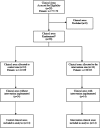Improving completeness of electronic problem lists through clinical decision support: a randomized, controlled trial
- PMID: 22215056
- PMCID: PMC3384110
- DOI: 10.1136/amiajnl-2011-000521
Improving completeness of electronic problem lists through clinical decision support: a randomized, controlled trial
Abstract
Background: Accurate clinical problem lists are critical for patient care, clinical decision support, population reporting, quality improvement, and research. However, problem lists are often incomplete or out of date.
Objective: To determine whether a clinical alerting system, which uses inference rules to notify providers of undocumented problems, improves problem list documentation.
Study design and methods: Inference rules for 17 conditions were constructed and an electronic health record-based intervention was evaluated to improve problem documentation. A cluster randomized trial was conducted of 11 participating clinics affiliated with a large academic medical center, totaling 28 primary care clinical areas, with 14 receiving the intervention and 14 as controls. The intervention was a clinical alert directed to the provider that suggested adding a problem to the electronic problem list based on inference rules. The primary outcome measure was acceptance of the alert. The number of study problems added in each arm as a pre-specified secondary outcome was also assessed. Data were collected during 6-month pre-intervention (11/2009-5/2010) and intervention (5/2010-11/2010) periods.
Results: 17,043 alerts were presented, of which 41.1% were accepted. In the intervention arm, providers documented significantly more study problems (adjusted OR=3.4, p<0.001), with an absolute difference of 6277 additional problems. In the intervention group, 70.4% of all study problems were added via the problem list alerts. Significant increases in problem notation were observed for 13 of 17 conditions.
Conclusion: Problem inference alerts significantly increase notation of important patient problems in primary care, which in turn has the potential to facilitate quality improvement.
Trial registration: ClinicalTrials.gov: NCT01105923.
Conflict of interest statement
Figures



References
Publication types
MeSH terms
Associated data
LinkOut - more resources
Full Text Sources
Medical

